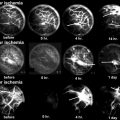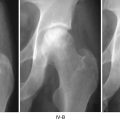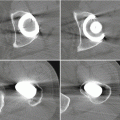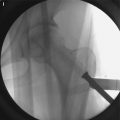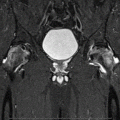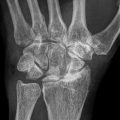Fig. 34.1
Proposed pathogenesis of nontraumatic osteonecrosis
34.3 Literature Review
34.3.1 Introduction
Many studies have sought to better understand the pathophysiology of osteonecrosis and, by extension, nonoperative interventions targeting the disease process itself. Most of the early research involves basic science studies on cell/tissue or animal models, but more recently, human clinical studies have been conducted. Several animal model s have been developed to evaluate various treatment strategies. Intramuscular injection of methylprednisolone has been used to develop steroid-induced osteonecrosis in primarily rabbit [7] models. However, other animal models have been developed including mouse [8], rat [9], pig [10], and chicken [6] models. These animal models have been used to study the molecular mechanisms of osteonecrosis and assess the usefulness of several therapies over the last few decades.
34.3.2 Statins: Pros and Cons
Statin s are 3-hydroxy-3-methylglutaryl coenzyme A (HMG-CoA) reductase inhibitors whose mechanism of actions is competitive inhibition of HMG-CoA reductase, the rate-limiting step in cholesterol biosynthesis. They occupy a portion of the binding site of HMG-CoA, blocking access of this substrate to the active site on the enzyme [15]. They are very common lipid-lowering drugs that have a wide variety of indications. Most common among these are dyslipidemia and coronary artery disease. Despite their success and popularity, statins like most drugs provide health benefits with some degree of risk, and risk–benefit assessments require ongoing review as new data become available.
Pros: Statins are safe lipid-lowering agents that have a wide range of benefits. A large FDA clinical trial has recently been conducted to look at the safety of statins. In this JUPITER study [16], the authors found that the participants previously considered to have low cardiovascular risk had clinically important health improvements with a hazard rate 44 % lower than that of the placebo group for myocardial infarction, stroke, arterial revascularization, hospitalization for unstable angina, or death from cardiovascular causes. A meta-analysis of 13 randomized statin trials with 91,140 participants showed an odds ratio of 1.09 for a new diagnosis of diabetes [17]. These studies suggest that the net cardiovascular benefit for people at high cardiovascular risk strongly favors statin use and that even patients with lower cardiovascular risk benefit greatly from these drugs.
Cons: It has been suggested that statins may lead to an increased risk of developing diabetes. The JUPITER study [16] showed that the hazard ratio for newly diagnosed diabetes was increased 25 % in the rosuvastatin group than in the placebo group [18]. However, as mentioned in the “Pros” section, other studies have shown that effect is very modest and primarily involves patients who were prone to developing diabetes. With regard to side effects that have been reported with statins, the FDA has determined that statins appear to be associated with a very low risk of serious liver injury, muscle injury (unless lovastatin is taken at high doses with other medications), and cognitive changes [19]. Recently, Mansi et al. tried to determine whether statin use is associated with musculoskeletal conditions, including arthropathy and injury [20]. They found that statin use is associated with an increased likelihood of diagnoses of musculoskeletal conditions, arthropathies, and injuries. This study did not imply any causality but is very interesting given the context of it being considered a nonoperative modality in the management of osteonecrosis (Table 34.1).
Table 34.1
Pros and cons of statin use
Pros | Cons |
|---|---|
Safe Lowers cholesterol Decreased risk of MI, stroke Decreased risk of arterial revascularization, hospitalization for unstable angina, or death from cardiovascular causes | Possible small increased risk of diabetes Very low risk of serious liver injury, muscle injury, and cognitive changes Increased likelihood of diagnoses of musculoskeletal conditions, arthropathies, and injuries |
34.3.3 Effect of Steroids on Stem Cell Morphology, Adipogenesis, and Bone Histology
The association between steroid therapy and the development of osteonecrosis has been observed since 1957 [21]. However, the pathophysiology behind this relationship has been elucidated in the past couple of decades. Stem cell studies have played an integral role in understanding the pathophysiology of steroid-induced osteonecrosis. Early studies with a cloned cell, D1, from the bone marrow have indicated that steroid-induced fatty changes in the bone marrow may be the mechanism whereby nontraumatic osteonecrosis occurs [22]. The effects of steroids on a cloned bone marrow cell showed that steroids produced adipogenesis and stimulated fat-specific gene, 422(aP2), expression which was dose dependent [23]. Other studies have shown that steroids decrease collagen synthesis and osteoblastic gene expression [24]. A study by Wang et al. developed a steroid-induced osteonecrosis model by treating pluripotential cells with dexamethasone and observing that these cells began to differentiate into adipocytes and expressed a fat-specific gene, whereas the expression of type I collagen and osteocalcin messenger ribonucleic acid decreased [25]. Kabata et al. found histological evidence of osteonecrosis first occurred 1–2 weeks after initial steroid [26]. At the same time there were significantly abnormal elevations in serum lipids, which persisted for between 1 and 2 weeks after the initial corticoid treatment. This study shows that osteonecrosis appears in rabbits shortly after steroids are first administered and that osteonecrosis in rabbits is chronologically associated with the onset of hyperlipidemia. This supports the occurrence of intraosseous fat embolism as a cause of osteonecrosis.
One can deduce from these studies that steroids increase fat accumulation in the marrow cavity leading to decreased blood inflow, increased intraosseous pressure, producing an intraosseous compartment syndrome, and leading to ischemia and nontraumatic osteonecrosis.
34.3.4 Effects of Statins on Stem Cell Morphology, Adipogenesis, and Bone Histology in Steroid-Induced Osteonecrosis Models
A landmark study by Cui et al. showed that lovastatin inhibited steroid-induced fat-specific gene expression, 422(aP2), and counteracted the inhibitory effects of steroids on osteoblastic gene expression [6]. In addition, when lovastatin was administered with steroids, less adipogenesis was observed and no bone death. Another study showed that lovastatin inhibited steroid-induced fat gene expression and counteracted the inhibitory effect of steroids on osteoblastic gene expression [26]. Li et al. helped elucidate the mechanism by which statins counteract steroid-induced osteonecrosis and osteoporosis [27]. They found that lovastatin enhanced osteoblast differentiation as assessed by a 1.8 times increase in expression of bone cell and fat cell transcription factors Cbfa1/Runx2 and by a 5 times increase in osteocalcin promoter activity. By enhancing osteoblast gene expression and inhibiting adipogenesis, the authors postulate that lovastatin may shunt uncommitted osteoprogenitor cells in the marrow from the adipocytic to the osteoblastic differentiation pathway. Iwakiri et al. found that simvastatin and pravastatin significantly reduced the incidence of steroid-induced osteonecrosis in rabbits via histological analysis of femurs [28]. Pengde et al. corroborated Iwakiri’s findings by histological analysis of femora and humeri. Pathological examination showed less serious adipogenesis and bone death in the statin group. In addition the size and area of the fat cells in the bone marrow were significantly smaller in the statin and normal saline groups than in the placebo group. This study showed that in an animal model, lovastatin can inhibit adipogenesis and decrease the rate of osteonecrosis [11]. Nishida et al. also found that statins (pitavastatin) decreased the incidence of steroid-induced osteonecrosis via histological analysis in rabbits and that the size of the bone marrow fat cells was smaller in the statin-treated group [29]. The data suggest pitavastatin has the potential to lower the incidence of steroid-induced osteonecrosis in rabbits.
These results indicate that steroid-induced adipogenesis in the bone marrow may contribute to osteonecrosis and that statins (esp. lovastatin) may be helpful in preventing the development of steroid-induced osteonecrosis.
34.3.5 Effects of Statins and Anticoagulants on Osteonecrosis
Kang et al. looked at the effects of the combined treatment with an anticoagulant (enoxaparin ) agent and a lipid-lowering agent (lovastatin) on prevention or decrease in the occurrence of steroid-induced osteonecrosis in rabbits [13]. Hematological examination for serum lipid levels and prothrombin time was carried out, and both femora and humeri were examined histopathologically for the presence of osteonecrosis. The incidence of osteonecrosis in the combined enoxaparin + lovastatin group (15 %) was significantly lower than that observed in the no-treatment group (68 %). The incidence in the enoxaparin-only and lovastatin-only groups was also significantly lower than that in the no-treatment group (31 and 35 %). The fat cell sizes of the bone marrow in both enoxaparin-only and lovastatin-only groups were lower than in the no-treatment group. The prothrombin time was prolonged and plasma lipid levels were reduced in the combined enoxaparin + lovastatin group during the study. This study showed that the combination treatment with an anticoagulant agent and a lipid-lowering agent can reduce the incidence of steroid-induced osteonecrosis in rabbits. Future evaluation in clinical practice is necessary, taking into account the deleterious effects of Lovenox therapy when not otherwise clinically indicated.
Stay updated, free articles. Join our Telegram channel

Full access? Get Clinical Tree


